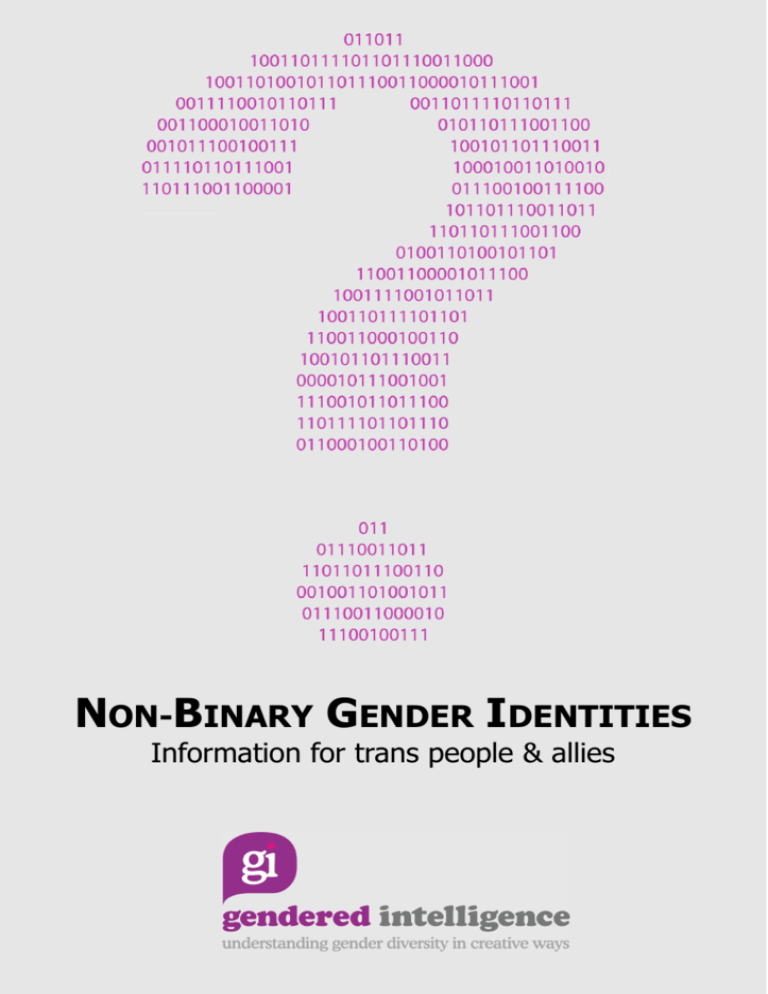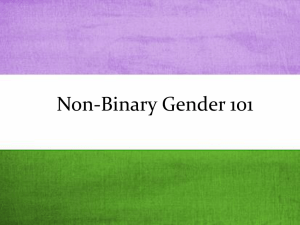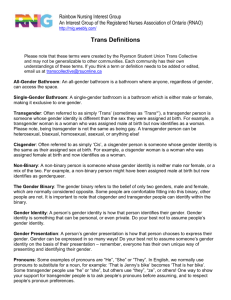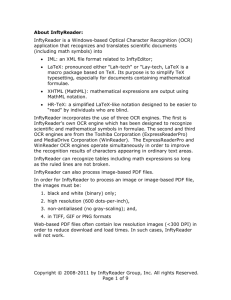
NON-BINARY GENDER IDENTITIES
Information for trans people & allies
Contents
Introduction
3
What is non-binary gender?
4
Sex vs gender
5
Non-binary identities
7
Identifying & presenting
as non-binary
8
Pronouns
9
Surgery & Hormones
11
Accessing Treatment
12
Sexuality
14
Respecting non-binary people
15
Glossary
17
Resources & Further Info
18
Support & social groups
19
2
Introduction
The aim of this booklet is to explain nonbinary
gender identities in a simple way.
Whether you're questioning your own gender
identity or you know somebody who identifies as
non-binary and want to try and better understand
it, we hope this booklet is helpful.
We've bolded lots of words in this booklet when
they are first used – you'll find definitions of these
words in more detail in the Glossary on page 16.
To find more about the work Gendered Intelligence
does, visit our website:
http://www.genderedintelligence.co.uk
3
What is non-binary gender?
When we think about gender, we often think
about it in the context of the gender binary.
The gender binary refers to the idea that there
are only two genders – male and female – and
that all people will fall into one or other of these
categories.
Non-binary is an umbrella term used to describe
gender identities that don’t fit within this
gender binary. People who have a non-binary
gender identity may feel that they fall outside the
strict categories of 'male' or 'female' entirely, or
that their gender identity incorporates parts of
both.
Non-binary gender identities fall under the
umbrella of ‘trans’ - a term applied to individuals
and groups whose behaviour varies from or
crosses conventional gender norms.
4
Sex vs gender
When we are talking about non-binary gender, we
are referring to the internal gender identity of a
person - their sense of self. We are not referring to
their sex - the physical characteristics of their body.
Sometimes, people are born physically intersex,
which means the sex characteristics of their body
are not exclusively male or female. This is not the
same thing as having a non-binary gender.
Non-binary refers to your gender identity, not the
physical sex of your body. Intersex people may have
a gender identity that is male, female or non-binary,
just like non-intersex people.
Non-binary is not another word for 'trans'. Some
trans people have a binary gender identity and will
identify as male or female. Non-binary only refers to
people who identify as something other than strictly
male or female.
5
Defintions
Non-binary is the umbrella term we use to refer to
identities outside of male and female. However,
some people may use more specific words to refer
to their gender. Others may just say ‘non-binary’.
Below are some that are commonly used terms with
a guide to their common definition. However,
individuals may define their identity slightly
differently to what is written here.
Agender - Having no gender identity or no gender
to express
Androgyne - Identifying or presenting between
‘masculine and feminine’ or ‘male and female’.
Bigender - Having two gender identities or
expressions, either simultaneously, at different
times or in different situations
Genderfluid - Moving between two or more
different gender identities or expressions at
different times or in different situations
Gender Neutral - Having a neutral gender identity
or expression, or identifying with a preference for
gender neutral language / pronouns
6
Genderqueer - Non-normative gender identity or
expression. Sometimes used as an umbrella term,
similarly to ‘non-binary’.
Intergender - Identifying or presenting between
‘masculine and feminine’ or ‘male and female’.
Neutrois - Identifying as non-gendered. Similar to
agender / gender neutral.
Third Gender - Having a gender identity that is not
defined in terms of the two binary options
(male/female, masculine/feminine), but on its own
terms.
Trans* - Identifying with the umbrella term covering
all gender identities or expressions that transgress or
transcend society’s rules and concepts of gender.
7
Identifying & presenting as
non-binary
There is no strict way to behave or present in order
to identify as non-binary. Non-binary people may
express their gender in completely different ways even if they both identify as the same label.
For example, two genderqueer-identified people may
look completely different. Just as people who identify
as male, for example, may have completely different
gender expressions, non-binary people are all
individuals and may have a unique identity or way of
presenting themselves.
Some non-binary people may look androgynous
and try to remove or hide gender cues, whereas
others may not look visibly androgynous at all.
Whichever way any particular non-binary person
needs or chooses to present, express or perform their
gender is as valid as any other.
8
Pronouns
Pronouns are words we use to refer to people’s
gender in conversation - for example, calling
someone ‘he’ or ‘she’. Many non-binary people are
happy to be referred to with ‘he’ or 'she’, or a
combination of both.
However, some non-binary people prefer to be
referred to using gender neutral language and
pronouns. Some may even choose a gender neutral
title such as, “Mx” or “Misc” for formal
communications, instead of Mr or Ms.
An example of some gender neutral pronouns used
by non-binary people are below. This is by no
means a full list!¹
they / their (singular)
ze / zir
xe / xem / xyr
e / em / es
1. See
http://en.wiktionary.org/wiki/Appendix:List_of_protologisms_by_topic/third_pers
on_singular_gender_neutral_pronouns for an extensive list of gender neutral
pronouns and their usage
9
Surgery & Hormones
Medically transitioning with surgery and
hormones is something people may usually
associate with binary gendered transsexual people
- i.e people who are transitioning from male to
female or female to male.
However, some non-binary people may choose to
have surgery (such as chest surgery / breast
augmentation, or genital surgery) or use hormones
(such as testosterone or oestrogen) in order to
make them more comfortable with their bodies.
There is no requirement for non-binary people to
have surgery or use hormones. However, it may be
that some non-binary people do experience body
dysphoria around the sex they were assigned at
birth and take steps to align their bodies more
closely with how they feel.
10
For example:
●
●
●
Some non-binary people may undergo transition
with hormones and genital surgery, similarly to
some binary trans people, but maintain their nonbinary gender identity.
Others may just use hormones for a short time
and not have any surgery.
Others may for example, have chest surgery or
breast augmentation, but not use hormones.
Or any range of combinations of surgery /
hormones - including none at all! The most
important thing for many non-binary people is
feeling comfortable in their skin - but this can mean
different things to different people.
11
Accessing treatment
Non-binary people who choose to transition
medically may struggle to access surgery and
hormones through the National Health Service,
which often has strict criteria about the order in
which treatment can commence (i.e hormones
before surgery).
Non-binary people who wish to do things in a
different order – or do some things but not others –
may face barriers in accessing treatment on the
NHS. This may vary depending on the clinic and
doctor.
Many non-binary people may present themselves as
having a binary identity in order to access
treatment. This is not always necessary, but some
people find this less complicated than explaining the
full extent of their gender identities to medical
professionals. How you proceed with your own
treatment path is up to you.
12
Sexuality
Being non-binary doesn’t impact upon who you
fancy - non-binary people can be attracted to men,
women, other non-binary people or no one at all!
However, most of the words we use to describe
sexuality assume that the person the label is being
applied to will identify as ‘male’ or ‘female’. For
example, when we call someone ‘straight’ or
‘heterosexual’, we assume they’ll either be a man or
a woman who is attracted to the ‘opposite’ sex.
However, if you fall outside of any of these
categories, defining your sexuality to others may be
difficult.
Non-binary people may use common words to
describe their sexuality but apply their own
definition - for example, identifying as ‘gay’ despite
not strictly falling under the categories of ‘male’ or
‘female’.
Other non-binary people may use words like queer,
which imply fluidity and a less strict definition of an
individual’s sexuality.
13
Some people who feel attraction to people
regardless of their gender may use pansexual
instead of bisexual to describe their sexuality. The
word ‘pan’ means ‘all’. This is more inclusive to nonbinary identities, as ‘bi’ implies there are only two
genders - which can exclude non-binary people.
Pansexuality implies an attraction to people
regardless of their gender identity or sex
characteristics.
It is best to ask someone how they would describe
their sexuality as opposed to making an
assumption.
14
Respecting non-binary people
●
●
●
●
Use the pronouns requested by the non-binary
person, even if it feels a bit odd at first. Genderneutral pronouns especially can take some
adjustment and sometimes be more difficult initially
than using straightforward ‘he’ or ‘she’ pronouns. If
you get it wrong, apologise and move on - but keep
trying your best.
If a non-binary person asks you to avoid using some
gendered language around them or inviting them to
gender-based events, respect that!
Don’t ask people what they ‘really’ are or details
about their assigned sex. Non-binary people are
really non-binary. The sex or gender assigned to
them at birth is irrelevant.
Similarly, if you do know the sex or gender someone
was assigned at birth, don’t ‘out’ them and tell other
people this information. It may be that is not
something a non-binary person would wish to be
publicised.
15
Glossary
Androgynous – Appearing neither male or female.
Body dysphoria – In trans people this refers to feeling
unhappy with the sexed characteristics of your body –
for example genitals, secondary sex characteristics, hair
etc.
Cisgender – Cis is Latin for 'same'. Cisgender refers to
someone who is not transgender, i.e someone born
physically female who identifies as female / a woman.
Gender binary – The idea that male and female are
the only two gender categories and that everyone will
fall into one or the other.
Gender identity – Someone's internal sense of self in
relation to their gender.
Intersex – Variations of sex characteristics, such as
chromosomes, genitals or reproductive organs which
make someone's body difficult to define as male or
female. In the past this made have been called
'hermaproditism', but this is incorrect and considered
offensive.
Medical Transition – Transitioning medically refers to
the process of taking hormones or having surgery to
realign an individuals body with their gender identity.
16
Non-binary – Having a gender identity that falls
outside of the traditional male / female or masculine /
feminine binary.
Pansexual – Being attracted to all genders.
Queer – A term that is often defined by the individual
using it. Often used as an umbrella term to refer to all
non-heterosexual or non-cisgender people. Also used to
refer to a more fluid and non-specific sexuality than
more traditional labels such as 'gay'.
Trans*– Identifying with the umbrella term covering all
gender identities or expressions that transgress or
transcend (go beyond the limits of) society’s rules and
concepts of gender.
Transsexualism – People with transsexualism are
usually people with binary gender identities who
transition using hormones or surgery. Some non-binary
people may however still identify as transsexual or has
having transsexualism, especially if they transition
medically.
17
Further information & Resources
Websites:
Gendered Intelligence
http://www.genderedintelligence.co.uk
Nonbinary.org
http://nonbinary.org/
New Statesmen – Non-binary: An
introduction to another way of thinking
about identity
http://www.newstatesman.com/lifestyle/2013
/01/non-binary-introduction-another-waythinking-about-gender
Genderqueerid
http://genderqueerid.com/what-is-gq
Neutrois.com
http://neutrois.com/community/
18
Support / social groups
Gendered Intelligence Youth Group
For all trans and questioning people, binary or
non-binary, in the UK aged 13 - 25. We meet
twice a month in London, as well as running
regular arts projects and a yearly camping trip.
http://www.genderedintelligence.co.uk
Trans*genderqueer London
Monthly social group for trans people in
London, actively genderqueer-inclusive.
http://transgenderqueerlondon.tumblr.com/
Trans London
TransLondon is a discussion / support group
for all members of the trans community.
http://www.translondon.org.uk/
19







